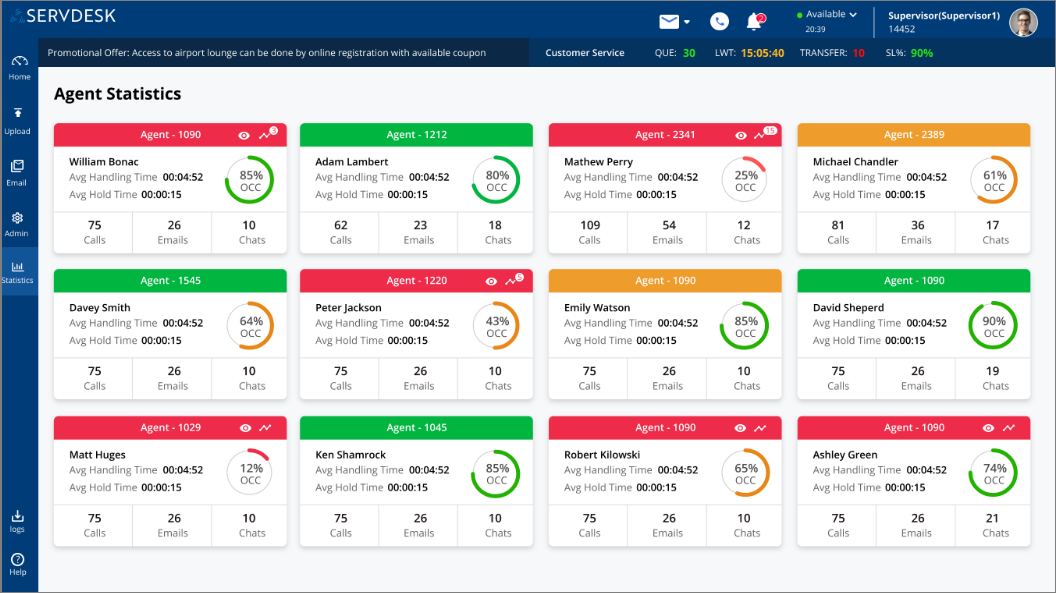AWS Feed
Building Personalized Customer Experiences Using Amazon Connect and Servion’s ServDesk

By Arpita Shah, Amazon Connect Practice Head – Servion
By Simon Burke, Partner Development Specialist, Amazon Connect – AWS
By Ayyakkannu Arvind, Partner Solutions Architect, Amazon Connect – AWS
 |
| Servion |
 |
Servion is an AWS Select Consulting Partner that believes every customer touchpoint can be converted into a long-lasting journey by managing the customer experience.
With market scenarios and end-customer expectations changing all of the time, Servion needed a contact center for its business that used agile technology and customer-centric features to help them innovate with speed.
When Amazon Web Services (AWS) launched Amazon Connect, an easy-to-use omnichannel contact center, Servion worked closely with the AWS team to start building expertise on the solution.
By successfully implementing and migrating contact centers to Amazon Connect, Servion became an Amazon Connect Service Delivery Partner. In this capacity, Servion has access to early releases of Amazon Connect features and can test them and make them available for demos, proofs of concept (PoCs), and enhancements for existing clients.
In this post, we share how to build differential and personalized experiences using Amazon Connect contact flows, AWS Contact Center Intelligence (CCI) services, and ServDesk agent widgets.
Servion-AWS Collaboration
Servion started collaborating with AWS on hosting custom applications built for contact center customers. This helped Servion acquire knowledge of AWS services related to security, administration, load balancing, database, and networking.
Servion also started exploring and experimenting with Amazon Connect and artificial intelligence (AI) services like Amazon Lex, Amazon Transcribe, and Amazon Comprehend.
During their learning journey with AWS, the team at Servion realized Amazon Connect provides flexibility to build customer experiences with AI services, and it empowers small and medium enterprises to provide differentiated customer experiences.
Servion started building hybrid contact centers with on-premises Interactive Voice Response (IVR) and remote agents spread across multiple manufacturing companies. Soon, the team progressed to building end-to-end Amazon Connect contact centers.
One customer for whom Servion built a cloud-based contact center was a pharma company in Asia. Servion consolidated three on-premises systems for three countries to a single Amazon Connect solution and cross-skilled agents to handle calls from other countries. The engagement included custom-built applications for the customer like holiday management, voice mail, custom reports, and agent desktop (ServDesk).
By using Amazon Connect contact flows, AWS Lambda, and Amazon Lex, Servion has also built various personalized and dynamic interactions with integrations to backend systems like Salesforce, homegrown customer relationship management (CRM), ticketing tools, and more.
Using integrations to these applications, Servion can authenticate the clients and provide self-service over various channels like voice, chat, WhatsApp, and Facebook Messenger.
About ServDesk
Servion has built various agent desktop widgets and features as accelerators to migration projects that complement the Amazon Connect Contact Control Panel (CCP).
All of the widgets together are called ServDesk—Servion Agent Desktop for Amazon Connect—which provides agents and supervisors with customer information. ServDesk features include interaction history, customer information display, contact store, disposition (wrap-up), and auto-dialing.
Figure 1 – ServDesk multi-channel agent screen while handling chat.
ServDesk is built with serverless architecture using AWS services such as Lambda, Amazon API Gateway, Amazon Relational Database Service (Amazon RDS), AWS Key Management Service (KMS), and Amazon Kinesis Data Streams.
The solution is auto-scalable and secured at every level of the architecture. Servion deploys ServDesk widgets into the customer’s AWS account, helping to mitigate data privacy and security concerns.
Figure 2 – ServDesk components and high-level architecture.
Configuring ServDesk Agent Widgets Using Admin Console
ServDesk has two applications, one for the agent and another for the admin and supervisor. The admin application controls all of the features and access of the widgets.
Users are synced and authenticated from Amazon Connect, and each user synced in ServDesk gets a unique numerical agent ID used for features like voice mailbox allocation, email allocation, and supervisor-to-agent team mapping. Admins can create various roles and permissions to define each feature that users across channels can access.
Figure 3 – ServDesk admin screens to define roles and access for users.
ServDesk Contact Store
ServDesk provides a contact store feature for small and medium enterprises that need a minimal CRM-like feature to store customer information but don’t need complete workflow management and customer lifecycle.
Contact store information can be configured to display on the agent screen during the interaction. Admins can use the admin console to select the information that can be displayed on the agent screen.
Figure 4 – ServDesk agent screen with customer information.
ServDesk Interaction History
Servion built an omnichannel customer interaction history using Amazon RDS, ServDesk’s contact store feature, and Amazon Connect’s detailed contact trace report, which provides past interaction details and outcomes to the agent. The small interaction timeline view can be expanded to show detailed information and access recordings and transcripts.
Figure 5 – ServDesk interaction history.
ServDesk Voicemail and Chatmail
Contact centers that opt for voicemail facility generally struggle with reporting and tracking the resolutions for voicemails left by customers. Most of the time, voicemails are left unanswered and forgotten to action in someone’s mailbox.
ServDesk resolves this issue by routing the voicemail to the agents assigned in the queue when available, and then reports the outcome just like an incoming contact. Voicemails are also part of the interaction history.
Like voicemail, customers can leave a chatmail (note dropped by the customer for the chat agent or organization when outside office hours). Chatmails are routed and reported to agents in the queues or direct agents like voicemail using ServDesk.
Add-On Widgets for ServDesk
Servion knows that no two customer needs are the same and their process may require more or different information. ServDesk is built with modular serverless architecture, making innovation and customization possible.
All of the features in ServDesk are built as widgets that make it easy to remove, replace, or add new features. Servion works with customers to define their agent screens and develop the widgets required to bring efficiency and ease of use.
Some of the common widgets asked for by customers are canned responses, manual recording controls, contact lens integration, auto-responses, custom reporting, and auto-dial.
Figure 6 – ServDesk Custom real-time dashboard.
Conclusion
Amazon Connect and ServDesk can help you build a contact center with customer experience in mind, which will provide a consistent experience across channels.
Together, ServDesk and Amazon Connect can reduce the customer effort score and improve customer satisfaction by configuring self-service at every touchpoint and assisting agents with all of the necessary information to handle the conversation effectively.
To learn more, see ServDesk – Agent Desktop Solution on the Servion website or contact marketing at Servion.
Servion – AWS Partner Spotlight
Servion is an AWS Select Competency Partner that believes every customer touchpoint can be converted into a long-lasting journey by managing the customer experience.
Contact Servion | Partner Overview
*Already worked with Servion? Rate the Partner
*To review an AWS Partner, you must be a customer that has worked with them directly on a project.





